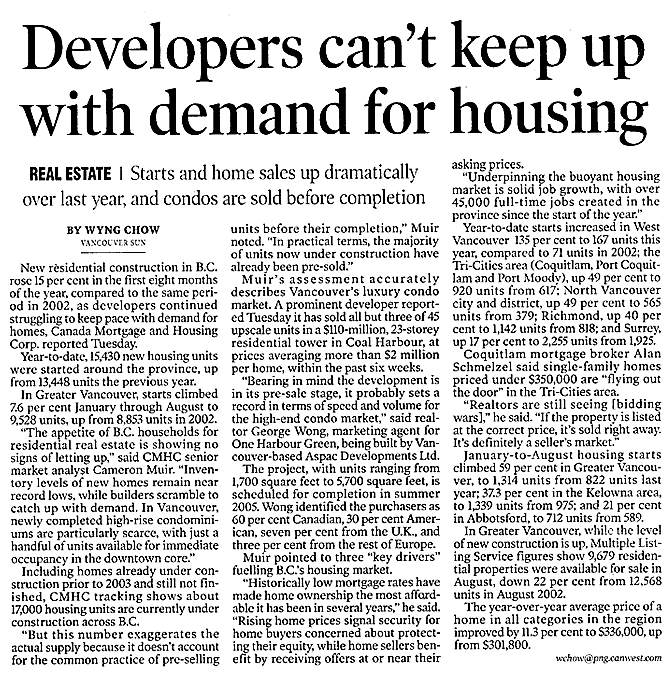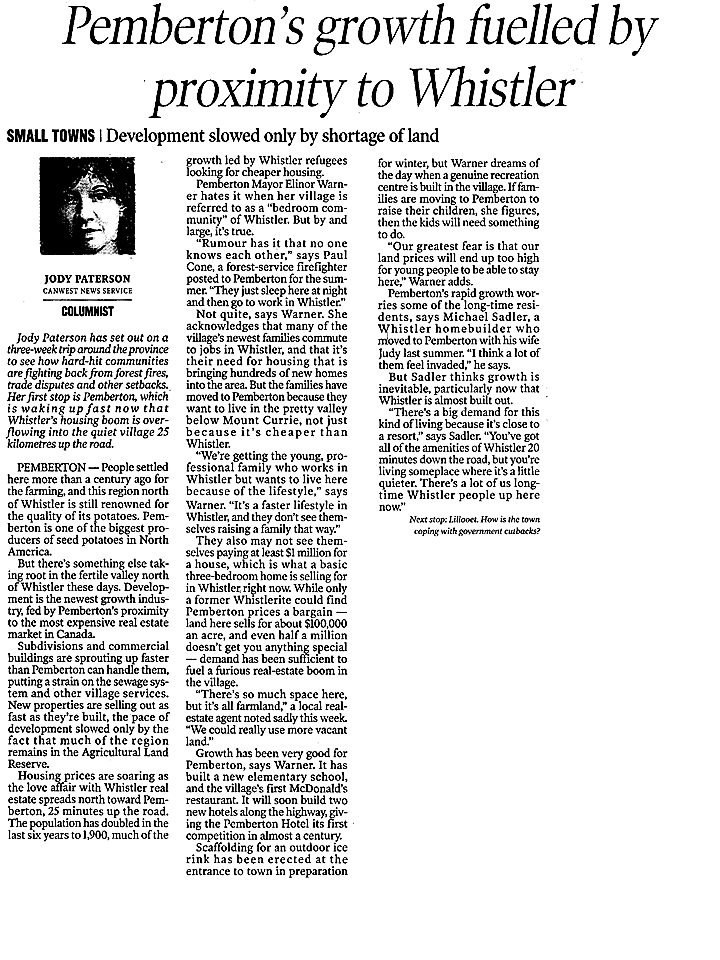Sun

Sun

Posted in Real Estate Related | Comments Off on Developers can’t keep up with deman for housing
William Boei
Sun

CREDIT: Ian Smith, Vancouver Sun Johnny Carline, chief administrative officer of the GVRD.
Greater Vancouver has to embrace sustainable development standards quickly before its remaining land that can be developed is lost to urban sprawl, according to a University of B.C. landscape design expert.
The situation is urgent because metropolitan Vancouver’s population is forecast to double from two million to four million by mid-century, said Patrick Condon, who heads UBC’s James Taylor Chair in Landscape and Livable Environments.
Regional government officials are already sold on shifting to green development principles, but they anticipate the process may take 30 years or more. By then, Condon said, it might be too late.
“The stakes are so high,” he said. “The Vancouver area is a very fragile landscape with not a lot of extra land to waste. We’re clearly on the verge of running out of land.”
Urban sprawl North American-style usually takes the form of subdivisions strung along arterial roads.
The subdivisions tend to be so spread out they are difficult to serve with public transit. Nothing is within walking distance, so suburbanites drive everywhere, creating traffic congestion, air pollution and health problems.
And so much land is paved that the soil can no longer absorb all the rainfall, resulting in lowland flooding.
Condon lobbies for a development model that includes denser subdivisions with smaller lots, narrower roads, various amenities — such as shopping, recreation and public transit — within walking distance, and enhanced drainage engineering to prevent flooding.
Many of those principles are being incorporated in the experimental East Clayton subdivision being built in Surrey. Condon helped to design it.
But Johnny Carline, chief administrator of the Greater Vancouver Regional District, said it may take decades before such principles become the region’s development standards.
Carline said he expects green principles to take hold more quickly in individual buildings, especially commercial and multi-family residential buildings “starting to implement new sustainable technology that maximizes and optimizes the use of energy, recycles energy and recycles water.”
The GVRD also favours using more natural drainage instead of massive storm sewer systems, and other principles being used in the East Clayton subdivision, Carline said.
Condon said he’s happy the GVRD embraces sustainable development principles, but argued that the way subdivisions are developed should be a higher priority.
“We have only a short amount of time to get the site development side right, if we go from two million to four million people within the next 40 or 50 years,” he said.
“If we don’t get the pattern right at first, it’s almost impossible to come in and retro-fit the pattern of the suburbs later. It’s much easier to retro-fit buildings than to retro-fit street designs.
“So I feel some degree of urgency for the priority of getting basic community design elements in order as soon as possible, such that the next two million people come into communities … which don’t require over-dependence on the automobile forever, and that can be served with transit, and that have modest impact on the surrounding ecology.”
There could be a public debate on such issues starting this fall.
The GVRD has been reviewing its long-term development plans, including its two-year-old Sustainable Region Initiative. This fall, it plans to introduce proposals that may include a model bylaw for municipal governments to adopt.
Green development principles are being explored, Carline said, while cautioning that it’s early in the process.
Condon countered that Greater Vancouver is already North America’s leader in sustainable development projects. Of the four most advanced projects in Canada and the U.S., three are located here:
– East Clayton.
– UniverCity, a community of 1,800 homes, mainly condominiums, apartments and townhouses, being built on Burnaby Mountain next to the Simon Fraser University campus.
– False Creek, a planned development on former industrial lands south of downtown Vancouver that will include the 2010 Winter Games Olympic Village.
The fourth project is located at Coffee Creek Ind.
“There is absolutely no question that British Columbia is leading North America in exploring these options to standard models,” Condon said.
© Copyright 2003 Vancouver Sun
Posted in Real Estate Related | Comments Off on New standards needed to stop urban sprawl
Wyng Chow
Sun
The provincial government has gained ownership of 3,845 hectares of land and mineral rights at Britannia Beach at no cost after entering into a public-private partnership with prominent Vancouver developer Rob Macdonald.
Macdonald, who donated all but 202 hectares of the 4,047-hectare (10,000-acre) property to Victoria, plans to redevelop about 162 hectares, contributing some of his profits toward the massive ongoing environmental remediation work required at the site of the historic Britannia Beach Mine.
Cleanup costs for the property, located 52 kilometres north of Vancouver on the Sea-To-Sky Highway, have been estimated at up to $70 million. The site was once known as North America‘s largest single source of metal contamination.
Stan Hagen, B.C.’s minister of sustainable resource management, said remediation of the pollution problem will be “the bedrock” for the renaissance and revitalization of Britannia Beach.
“The big-picture benefits are significant,” Hagen said. “The [3,845 hectares] that have been acquired at no cost to the province of B.C., along with other contributions from Macdonald, means that we will be able to complete the land remediation work, [leading] ultimately to a healing of the Britannia environment.
“The acquisition of fee simple title of the Britannia land by the province will create positive ripple effects now and into the future. For example, the rights of ways are absolutely essential in the building of highways, which will increase tourism and other Sea-To-Sky activity.”
Eventually, the government’s proposed realignment of Highway 99 will go right over part of the Britannia property. Victoria would also entertain other redevelopment proposals to turn the area into a major tourist destination.
On Aug. 18, Macdonald’s numbered company, 400091 British Columbia Ltd., was granted an order by B.C. Supreme Court Justice John Sigurdson, awarding the firm ownership of the Britannia lands.
The court had pronounced an order of foreclosure on the private property after the former owners, Copper Beach Estates Ltd., defaulted on a first mortgage held by Macdonald, who was owed more than $17 million.
Excluding mineral rights, the 4,047 hectares of land had an appraised value of $10.2 million.
While signing over title to most of the property to the B.C. government — the deal closed Tuesday — Macdonald indicated he intends to redevelop about 162 hectares, probably for residential uses.
His proposal would also include retention of the existing community of Britannia Beach, as well as commercial development along the Sea-To-Sky Highway, on the road to Whistler, the major site for the 2010 Winter Olympics.
Macdonald will turn over an unspecified percentage of all development income to Victoria for maintenance and operation of the province’s environmental plan for the area.
“We’re honoured to be a part of the rebuilding of the Britannia Beach Mine site,” said Macdonald, president of his privately-held Vancouver-based company, Macdonald Development Corp.
“To create a successful community, a healthy foundation, literally environmental remediation, it is here you have to start.
“When you add the location, the view (of Howe Sound), the historic aspects of various buildings that we’ll save and incorporate, and a mining-themed commercial centre, it makes for a very interesting project.”
The Britannia Mine was once the largest copper mine in the British Empire. During its operations by various pioneers and mining companies between 1904 and its closure in the mid-1970s, it produced some 50 million tons of ore, including copper, zinc, lead, gold and silver.
However, the mining activity also left a legacy of serious water pollution as a result of acid rock drainage, killing fish in Howe Sound. In late 2000, several remnant companies of the original mine operators agreed in an out-of-court settlement to provide $30 million toward site remediation.
Meanwhile, the B.C. government is also asking the federal government to contribute, since Ottawa operated the mine during the two world wars under a federal Crown corporation.
Environmentalists have applauded the remediation efforts that started several years ago, including installation of an earth plug to seal a crucial mine opening to prevent Britannia Creek — once dubbed B.C.’s most endangered river — and the surface waters of Howe Sound from being contaminated.
Since the plug was installed by University of B.C. engineers, metal levels in the creek waters have reportedly dropped to insignificant levels, while aquatic life is returning to lower reaches of the stream.
© Copyright 2003 Vancouver Sun
Posted in Real Estate Related | Comments Off on Britannia Beach P3 Boosts Cleanup Effort
Sun

Posted in Real Estate Related | Comments Off on Pemberton’s growth fueled by proximity to Whistler
You are currently browsing the Les Twarog Vancouver Real Estate and Condo Blog blog archives for September, 2003.
Les Twarog Vancouver Real Estate and Condo Blog is proudly powered by
WordPress
Entries (RSS)
and Comments (RSS).
Articles are from various sources and courtesy to The Vancouver Sun, The Vancouver Province, The Vancouver Courier, USA Today, and others.

Bad Behavior has blocked 10319 access attempts in the last 7 days.
grey